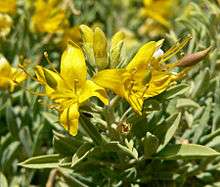Peritoma arborea
Peritoma arborea (formerly Isomeris arborea,[1] syn. Cleome isomeris), is a perennial shrub or bush in the spiderflower family (Cleomaceae) known by the common names bladderpod, bladderpod spiderflower and burro-fat.[2][3][4][5] It has yellow flowers in bloom all months of the year.[4] It emits a foul odor to discourage herbivory from insects.[4]
| Peritoma arborea | |
|---|---|
 | |
| Scientific classification | |
| Kingdom: | Plantae |
| Clade: | Tracheophytes |
| Clade: | Angiosperms |
| Clade: | Eudicots |
| Clade: | Rosids |
| Order: | Brassicales |
| Family: | Cleomaceae |
| Genus: | Peritoma |
| Species: | P. arborea |
| Binomial name | |
| Peritoma arborea (Nutt.) Iltis | |
| Synonyms | |
| |
Range and habitat
Peritoma arborea is commonly found along roadsides, desert dry washes, and flat areas up to 4,200 feet (1,300 m), in the western Mojave Desert and Colorado Desert to Baja California Peninsula.[6][4] It is native to California and Baja California Peninsula where it grows in a variety of habitats usually described as desert or brush.[6]
Description
It is a densely branching shrub 0.5–2 metres (1 ft 8 in–6 ft 7 in) high covered with tiny hairs.[2][4] Its stalked leaves are generally composed of three equal leaflets 15–45 millimetres (0.6–1.8 in) long, oval to elliptic in shape and pointed at the tip.[2][4] The plant produces abundant inflorescences at the ends of the stem branches much of the year.[4] The four sepals are fused about halfway from their base. Each flower has four bright yellow 8–14 millimetres (0.3–0.6 in) long petals, six protruding 15–25 millimetres (0.6–1.0 in) stamens with 2–2.5 millimetres (0.1–0.1 in) anthers. The style is 0.9–1.2 millimetres (0.04–0.05 in) or aborts before flowering.[2] The fruit is a leathery prolate spheroid capsule 30–60 millimetres (1.2–2.4 in) long and 10–25 millimetres (0.4–1.0 in) wide on a 10–20 millimetres (0.4–0.8 in) stalk. It is smooth and green when new, aging to light brown.[2]
A typical inflorescence bears a number of flower buds at its tip, open flowers proximal to the buds, and maturing fruits which have shed their flowers below these.
In the previous genus name, "Iso" means "equal", and "meris" means "part", referring to the stamens being of equal length.[7]
References
- Mojave Desert Wildflowers, Pam MacKay, 2nd Ed. 2013, P. 314
- "Peritoma arborea". in Jepson Flora Project (eds.) Jepson eFlora. Jepson Herbarium; University of California, Berkeley. 2018. Retrieved 2018-07-06.
- USDA, NRCS. (2018). "Cleome isomeris". The PLANTS Database. National Plant Data Team, Greensboro, NC 27401-4901 USA. Retrieved 2018-07-06.
- Mojave Desert Wildflowers, Pam MacKay, 2nd Ed. 2013, p. 230
- Flora of North America Editorial Committee, ed. (1993–2018). "Peritoma arborea". Flora of North America North of Mexico. 20+ vols. New York and Oxford. Retrieved 2018-07-18.
- Sullivan, Steven. K. (2018). "Peritoma arborea". Wildflower Search. Retrieved 2018-07-06.
- Torrey, J. & A. Gray. A flora of North America. 1838 [-1840]. volume 1.page 124.
External links

- Photo gallery